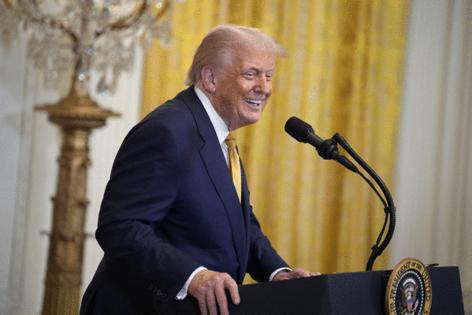Trump is getting his way in his global trade war, like it or not
Published in News & Features
WASHINGTON — When President Donald Trump rocked the economy with an unprecedented attack on global trade in April, the plan was dismissed as swaggering, capricious and unsustainable. Market meltdowns and price increases would teach the White House the true cost of its mistakes, economists warned.
Yet, four months later, Trump is largely getting his way, refashioning the global economic order around his long-standing worldview that the United States has been ripped off for decades — all before the economy can fully absorb the shock.
Prices are ticking up, but markets have rebounded, and consumer confidence is resurgent after Trump backed down from his most draconian threats. Projections of a looming recession are being tempered. And a handful of deals have been struck that, on their surface, give Trump much of what he wanted.
A long road ahead
Experts still warn that the net effect of Trump’s trade war will hurt the U.S. economy, slowing growth and raising prices in the short term while depressing living standards in the long term.
A handful of preliminary agreements with important trading partners have been announced in recent days. But the president said Wednesday that he was committed to raising tariffs on others by Friday.
“THE AUGUST FIRST DEADLINE IS THE AUGUST FIRST DEADLINE — IT STANDS STRONG, AND WILL NOT BE EXTENDED,” Trump wrote on social media. “A BIG DAY FOR AMERICA!!!”
That leaves the most valuable U.S. trading relationships vulnerable to devastating rate hikes that could severely roil the U.S. economy by the holiday season, when U.S. retailers make as much as a quarter of their annual sales, experts said. Trump said Wednesday he would raise the tariff on India to 25% and on Thursday extended Mexico’s current tariff rates for 90 days to allow more time for negotiations.
The most dramatic provisions in the biggest deals struck thus far — with the European Union, Japan, the United Kingdom and Vietnam, among others — lack enforcement mechanisms and are, in some cases, downright fanciful, such as an EU pledge to purchase $750 billion in American energy over the next three years.
Yet, despite raising tariff rates in those deals up to an average of between 15% to 20% — higher than the 10% baseline that Trump unveiled in April, itself a marked increase from historic standards — Trump’s reversals on his most dramatic levies, such as a 125% import duty on Chinese products, have helped calm markets and buoy business confidence.
The gap between reality and public perception is evident in recent economic data, which show slowing U.S. growth but rising U.S. consumer confidence.
U.S. economic growth last year was at 2.8%. This year, economists warn that the country is still on track for less than 2% growth overall, a slowing rate not seen since the height of the COVID-19 pandemic that began in 2020.
“The president’s recent push on trade has produced a flurry of agreements that, while stopping short of the sweeping free‑trade deals of past administrations, have headed off the threat of a full‑blown tariff war,” said Sung Won Sohn, an economist and a former commissioner at the Port of Los Angeles.
“The administration has managed to calm immediate fears of a trade shock while locking in a costlier trading environment,” he added. “The deals represent progress, but the toughest negotiations — with some of America’s most important partners — still remain.”
‘Fragile’ deals
The deals Trump has cut so far amount to loose conceptual frameworks that have not been formalized through U.S. or foreign governing systems — and will ultimately survive at the whims of a president who has thrown out his own trade deals before.
The United States-Mexico-Canada Agreement, or USMCA, was a genuine trade deal negotiated by Trump himself during his first term in 2020 that overhauled trade across the continent. Yet that has not stopped him from entering a retaliatory spiral over trade with Canada and putting extraordinary pressure on Mexico’s president, Claudia Sheinbaum, to bend to painful U.S. demands.
“It is fair to say no comprehensive trade agreements have been reached really with any of our trading partners,” said Stan Veuger, a senior fellow in economic policy studies at the American Enterprise Institute and a frequent visiting lecturer at Harvard, referring to the settlements reached thus far as “side deals.”
Those deals, he said, “have been limited in scope, and can only be read as an effort to get the U.S. government to calm down and focus on something else.”
“They are also very fragile, as they are ill-defined, barely formalized or not at all, and especially on the U.S. side a mere product of executive action,” Veuger said.
“Neither the tariffs nor the side deals,” Veuger added, “seem to reflect any kind of broader strategy other than trade is bad and tariff revenue is good.”
Recession fears remain
After Trump’s “Liberation Day” announcement of global tariffs April 2, nearly every U.S. financial institution issued forecasts warning that a U.S. recession this year was more likely than not.
Those forecasts have been downgraded — but the risk is still significant, analysts say. According to J.P. Morgan, the probability of a recession has fallen to 40%. Apollo Global Management warned that the fate of U.S. economic growth probably would fall on the administration’s ongoing trade negotiations with China.
“In this first round of the trade war, Trump has triumphed, at least on the terms he set out for himself. The way the EU caved, in particular, is stunning,” said Kenneth Rogoff, a prominent economist and professor at Harvard. “That said, so far the tariffs seem to have been mostly paid by U.S. importers, not foreign countries that export to the U.S. Eventually, now that the war has settled down, the cost will be passed on to consumers.”
Rogoff still put the odds of an “outright recession over the next 18 months” at greater than 50%.
“It is very likely that there will be some modest inflation over the next year and weaker growth,” he said, adding, “it is already becoming harder to find jobs in many sectors.”
©2025 Los Angeles Times. Visit at latimes.com. Distributed by Tribune Content Agency, LLC.







Comments